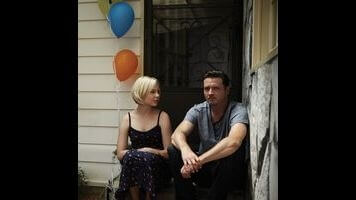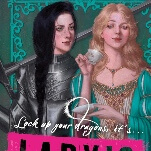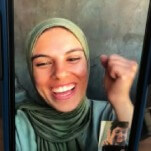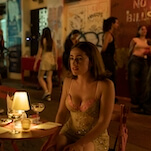There’s no architectural feature that Rectify appreciates more than a good window. Its favorite is the one that peers into Daniel Holden’s cell from the prison hallway, a box-within-a-box emphasizing and exaggerating the confinement of death row. But a window is also a symbol of opportunity, a passageway to the rest of the world, and “Running With The Bull” takes tremendous advantage of those qualities, framing several characters within or in front of windows: Kerwin in the cell door; Ted Jr. and the Paulie Tire & Rim storefront; Senator Foulkes and the rain-streaked panes in Sheriff Daggett’s office.
In “Running With The Bull,” it’s especially noticeable how the show uses windows to flood its sets with light. Returning to Rectify a full year after “Jacob’s Ladder,” I’ve been trying to put my finger on why the series has such a deep emotional effect on me, and I think the light is a big part of it. On a show depicting such profound hurt—“Everything out here is just so complicated. There’s so much pain and hate,” Daniel says at one point in tonight’s episode—the glow seeping in from outside goes a long way toward maintaining a leavening sense of warmth. In the most traumatic of the premiere’s dream sequences, Daniel attempts to block any intrusions from the outside, refusing to open the door for prison officials (like he has a choice) and blocking the window with marked-up book pages. The light will not reach Daniel Holden, until it forces its way past his defenses.
Daniel is having difficulty seeing the light in the most literal fashion this week, as his eyes are swollen shut in the wake of the attack carried out by Bobby Dean and crew in the first-season finale. In Daniel’s head, “Running With The Bull” picks up directly where that episode left off, with the overhead view of Daniel and Kerwin’s adjoining prison cells. That striking image is more of an imagined flicker than it ever was before, now presented as the hallucination of a coma patient rather than the memory of a man thrust back into the world after 19 years of isolation. In the real world of Rectify, only a few hours have passed between seasons—a short enough amount of time that Daggett’s still at the cemetery looking at tire tracks—but the pace of the show is already accelerating. More than one day passes over the course of the episode; while Daniel lies in recovery, visiting with the ghosts of his prison stint, Paulie carries on. At the tire store, Ted tries to get back to normal life, but the coffee pot’s still there, a reminder that Daniel’s return redefined “normal” in the Holden and Talbot households.
Elsewhere, “Running With The Bull” marks the start of a new chapter in the Rectify story: Refresher courses on the show’s premise are offered by the senator and a TV news report overheard in the Dean living room, but Daniel’s incapacitation shifts the show’s focus ever so slightly. The premiere provides more space for the family drama (has there been a better symbol of Amantha attempting to protect her brother than Abigail Spencer cradling a bag full of his bloodied clothes?), and there’s a renewed emphasis on the procedural element of the series in the Daggett storyline. The episode breaks from Daniel’s orbit, but happenings in Paulie continue to orbit around the man, with the ambush in the cemetery forming a big obstacle in the political careers of the sheriff and the senator. There’s so much more world outside of Rectify’s window now, more characters that the viewers are familiar with and that the show can explore.
The wider focus dilutes the premiere to some degree, as the episode busies itself with Daggett’s investigation, a visit to Trey Willis’ place, and that little slice of the Dean’s home life. So much of the show (and, indeed, so much of “Running With The Bull”) is filtered through Daniel’s eyes that some of these personalities remain a little thin—Senator Foulkes especially. We feel his pain in the scene in front of the sheriff’s office window, but he remains the closest Rectify has to a clear-cut villain, a man whose certainty about Daniel’s death is only outweighed by his verve for the governor’s seat.
But I’m willing to wager that we’ll see a softer side of Foulkes before too late, because this is still very much the same Rectify with the same philosophically empathetic outlook. When Tawney tells Amantha that she can’t understand how God would plan something as tragic as Daniel’s beating, Amantha counters that no one planned for this to happen. “I just have to believe that it’s all some cosmic cause-and-effect or just plain random,” she counters—because Rectify defies the easy answers. It doesn’t want to assign heroes or villains, angels or demons, believers or skeptics—it’s just a show about humans. In fact, it might be the most human show, a motion-picture story told in a fashion mimicking the fullest range of emotion and acknowledging the fullest range of behavior. It affords this courtesy to Daniel’s old friend Melvin, who could be rendered as a twitchy wreck of social awkwardness if the camera didn’t stick around long enough to register the effect his kindness has on Amantha. “Running With The Bull” also displays the toll Daniel’s attack had on Bobby Dean, who doesn’t appear to have found the catharsis he went looking for in that graveyard. Even Trey, whom the show still has suspicions about, gets to be a good dad for a second or two. (This review originally attributed George’s death to Trey; a correction has been made.)
The ecstasy Kerwin experiences in the pasture from “Drip, Drip” could seem antithetical to a series so suffused with agony—but the truth is that Rectify would rather marvel at the weird wonder of human existence than damn its characters for their mistakes. The show makes its own excuses to be happy, and the way it’s put together—with its saturated photography and its soundtrack of tone poems and manipulated ambience—creates an uncanny, distinctive swell of emotion. I suppose it depends on your amount of investment in the show, but distractions from government officials aside, “Running With The Bull” was all chills from me from the moment Amantha and Janet are first seen at Daniel’s bedside. It can be difficult to fully articulate my appreciation for this show, but this second-season premiere makes it a little easier: It’s all of the elements that work in concert to keep the series compelling and to keep it human. The performances, the locations, the music—all of these different textures, to borrow a term from a fellow TV Club writer.
And it’s in those windows, too: Means of escape that also give the viewer a decent view inside themselves.
Stray observations:
- Welcome to The A.V. Club’s second-season coverage of Rectify. For those who were around the first time, glad to have you back; salutations to those who discovered the show between seasons. This really is one of my favorite shows to write about, and I hope you’ll be checking back in with me through August. If you want to continue the conversation started in these reviews, you can find me on Twitter @ErikMAdams.
- Favorite shot(s) of the premiere: Definitely those close-ups of Daniel and Kerwin in the pasture, with the shallow depth of field. It’s like the whole world’s glimmering behind them.
- Daniel’s comment on the statue he found on his walkabout with Dan Dority is loaded: “I had grown fond of her, but she’s lost her head.”









































